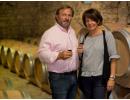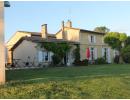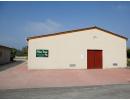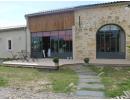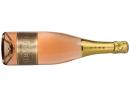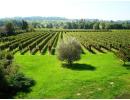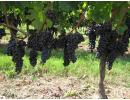Dubard
DUBARD Brut NV Rosé - Crémant de Bordeaux
The wine's blend is 50% Merlot and 50% Malbec. The vines have an average age of 35 years old producing a yield of 50 hl/ha. Once the grapes have been destemmed they are pressed and the colour rosé is obtained within a couple of hours. The fermentations are carried out in stainless steel vats at 14°C for 4 to 5 weeks. After the fermentations the juice is left to settle until February the following year. Once bottled the wine is aged for a minimum of 12 months on laths in the underground limestone cellars located under the village of Saint Emillion. Here the conditions are ideal for the second fermentation to take place, the temperature is naturally 12°C year round. The riddling "remuage" is done manually. After the disgorgement to remove the sediments, the dosage is done as "Brut" varying from 8 to 9 g/l.
PVins notes: The wine is pink salmon in colour, the nose shows empyreumatic aromas, the palate is fresh with pleasant subtle flavours complemented by fine bubbles and a complex and expressive finish. A great festive sparkling to be consumed within 3 years of release.
From the same producer see Château Nardou - Francs Côtes de Bordeaux.
Other wines produced by the family Dubard are Château Laulerie - Bergerac and Château La Croix Romane - Lalande de Pomerol.
The DUBARD Crémant de Bordeaux is produced by Château Nardou owned by Florent and Florence Dubard since 1998. The château is located 10 kilometres North-East of Saint Emilion at Tayac in the heart of the Francs Côtes de Bordeaux appellation. Florent is originally from the the neighbouring Bergerac region where he was involved with his brother and sister in the running of the well-known Château Laulerie. Since 1998, Florent has made important investments to produce high quality wines. A new cellar was built and small concrete vats for a plot by plot approach were installed and stainless steel vats were added for the production of the Crémant. A bottling machine was also purchased as the new cellar also provides more room for storage. Since 2012 a new reception area with a tasting room is operational. Château Nardou has always been known to produce still red wines, but in 2009 Florent decided to produce a Crémant de Bordeaux (sparkling) rosé under the name DUBARD. Florent is now one of the few winemakers of the Crémant de Bordeaux appellation as they are only about 100 producers.
Florence and Florent also provide Bed & Breakfast stays and have 2 cottages that you can book. Your visit in the area will be memorable by the scenery and peacefulness of the location. Of course Florent will look after you for you to discover the wines of Château Nardou, its vineyard and the nearby forest. Don't forget that the UNESCO village of Saint Emilion is only 10 kilometres away.
Château Nardou's 15 ha are planted at a density of 5,000 vines per hectare. The vines have an average age of 35 years old and are mainly planted facing south on slopes enabling good drainage and plenty of sun exposure for the grapes to reach an excellent maturity. The terroir is clay-loam and limestone based.
The grapes varieties planted are classic for Bordeaux reds with the Merlot representing 70% of the vineyard then Cabernet Sauvignon, Cabernet Franc and Malbec each representing 10%. The vineyard is sustainably farmed to protect the environment and grass is grown between the rows to enable bio-diversity. Canopy management and green harvest are practiced to control the yields and improve the ripeness of the grapes.
As a first step, the grapes are hand-picked at full maturity producing an average yield of 50 hl/ha. Once the grapes have been destemmed they are pressed and the colour rosé is obtained within a couple of hours. The blend is 50% Merlot and 50% Malbec and the vines' average age is 35 years old. The fermentations are carried out in stainless steel vats at 14°C for 4 to 5 weeks. After the fermentations the juice is left to settle until February the following year. Once bottled the wine is aged for a minimum of 12 months on laths in the underground limestone cellars located under the village of Saint Emillion. Here the conditions are ideal for the second fermentation to take place, the temperature is naturally 12°C year round. The riddling "remuage" is done manually. After the disgorgement to remove the sediments, the dosage is done as "Brut" varying from 8 to 9 g/l.
Links: Bordeaux map
CREMANT DE BORDEAUX
The Crémant de Bordeaux appellation created in 1990, is one of the 57 appellations of the Bordeaux region. The sparkling wines can be produced in any of the 501 communes out of the 542 that make up the Gironde region. But the appellation’s production at present only represents the equivalent of 200 hectares from 108 producers, which is not much considering the Bordeaux region has 117,500 hectares of vineyards with over 10,000 producers. Some of the appellation's regulations are: the grapes must be hand-picked, only white and rosé Crémants can be produced, the second fermentation must be done in the bottle (same as chamgagne), the wine must be aged on laths for a minimum of 12 months and the rosé's colour may be obtained either by saigné, skin contact or a blend of white and red wines before bottling. In 2009, a new decree for the elaboration of all French Crémant was introduced to implement the same quality standards throughout France’s wine regions, of course each appellation's specificities such as the local grapes, climate etc.... were taken into account.
The Bordeaux white Crémant are produced with the following grapes varieties which must represent at least 70% of the blend: Cabernet Franc, Cabernet Sauvignon, Carmenère, Malbec, Merlot, Muscadelle, Petit Verdot, Semillon, Sauvignon Blanc, Sauvignon Gris. The secondary grapes which cannot be more than 30% of the blend are Colombard, Merlot Blanc and Ugni Blanc. But the majority are Semillon and Sauvignon Blanc based.
The Bordeaux rosé Crémant is produced with the following red grapes: Cabernet Franc, Cabernet Sauvignon, Carmenère, Malbec, Merlot, Petit Verdot.
Climate
Bordeaux's climate is usually classified as oceanic, however the summers tend to be warmer and the winters milder than most areas of similar classification. Winters are cool because of the prevalence of westerly winds from the Atlantic. Summers are warm and long due to the influence from the Bay of Biscay. The average seasonal winter temperature is 7.1°C, but recent winters have been warmer than this. Frosts in the winter are commonplace, occurring several times during a winter, but snowfall is rare. The average summer seasonal temperature is 20.7 C even though temperatures often reach the high 20s in the summer months of June to August. The region’s climate is also influenced by the Gironde estuary moderating extreme temperatures and the pine forest "Les Landes" protecting against strong westerly winds from the Atlantic Ocean.



